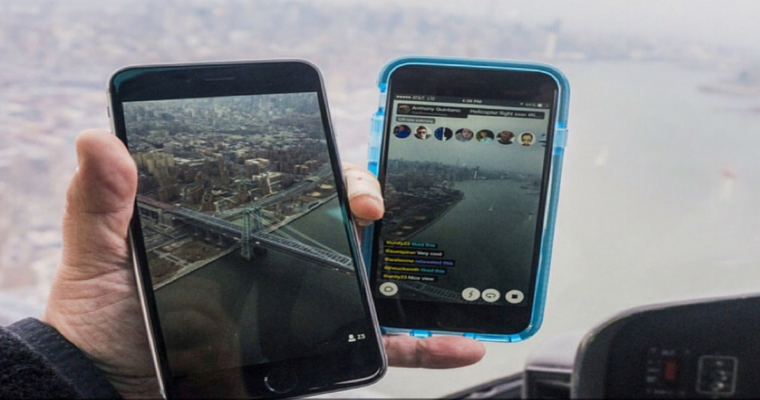Live social streaming: it’s the hot new thing that has digital marketers and the general public buzzing. But as with all the new tools that launch year after year, businesses must determine is it too early to test new waters. Will this stretch the social media team and resources too thin? Will there be enough of return on the time and effort to try something new?
Before any of those decisions can be made, education is necessary. Keep reading to get a comprehensive look into the latest live streaming apps, how they stack up to other live streaming options, and what to consider as you ponder adding these new options to your social marketing mix.
A Comparison of Meerkat and Periscope
Both Periscope and Meerkat are mobile apps that enable a user to broadcast a live video feed to other members of the network from their mobile device. Both apps are now available for both Apple and Android smartphones. At this time, Meerkat is also available for iPad, and most likely there will be an iPad version of Periscope soon. Both apps allow you to save the video captured by the camera on the device used.
Both apps are also new to the market for 2015. Similar apps have been available in Europe for a longer period of time, so the adoption rate for overseas users tends to be higher than for US users at the moment.
Periscope
Periscope has the advantage of full social graph integration with Twitter. New users can sign up with a Twitter account and easily find Twitter connections in the app. The user interface in Periscope is also very clean and easy to use. Although users cannot schedule a broadcast in Periscope, they can make the video content with comments and engagement available to the network for a full 24 hours after the broadcast, giving new connections a better window of discovery.
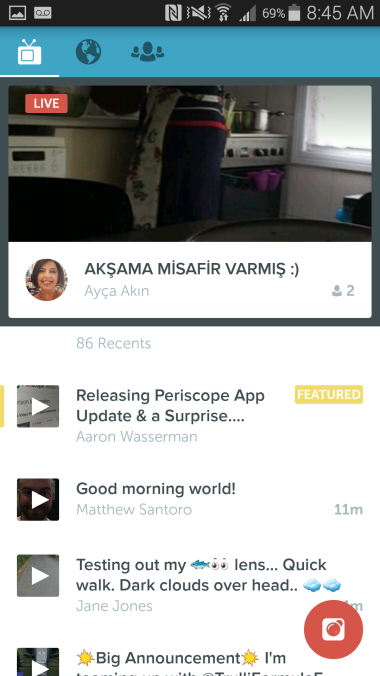
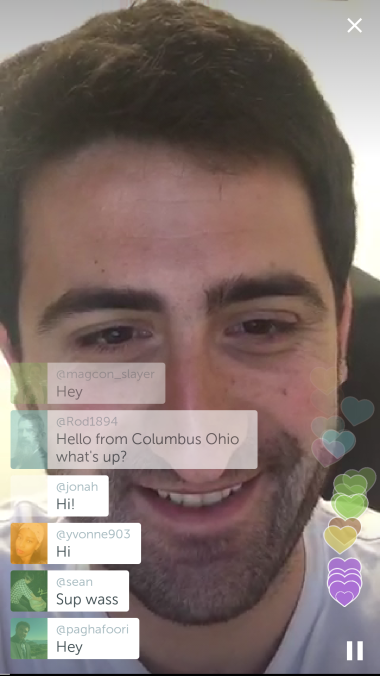 Screen shot taken June 19, 2015 of Periscope Android App
Screen shot taken June 19, 2015 of Periscope Android AppMeerkat
Meerkat gives users more information about the live broadcast, but this leaves the interface looking very cluttered. Although Meerkat does not currently offer a replay option, users can schedule and promote a broadcast in advance. Sharing broadcasts that a user is watching is easier from Meerkat to Twitter. In Periscope, users are only able to share a broadcast inside the Periscope network. As mentioned earlier, Meerkat also is the first out with an iPad version of the app. On the larger tablet screen, the clutter becomes less of an issue.
In Periscope, users are only able to share a broadcast inside the Periscope network. As mentioned earlier, Meerkat also is the first out with an iPad version of the app. On the larger tablet screen, the clutter becomes less of an issue.
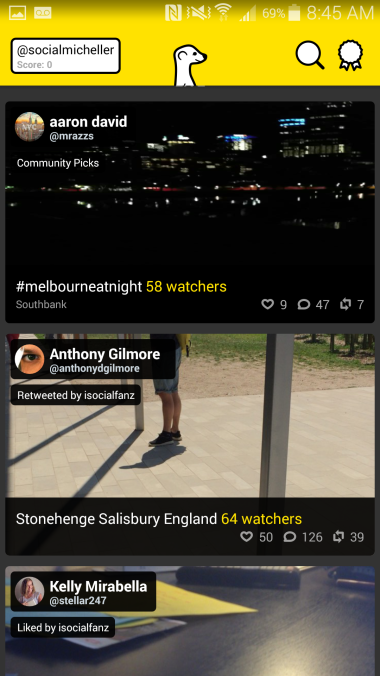 Screen shot taken June 19, 2015 of the Meerkat Android App
Screen shot taken June 19, 2015 of the Meerkat Android App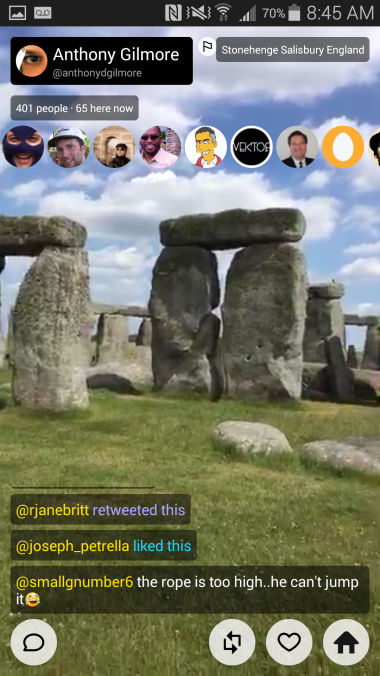 Screen shot taken June 19, 2015 of the Meerkat Android App
Screen shot taken June 19, 2015 of the Meerkat Android AppLive Streaming Video
The ability to broadcast a live video feed is nothing new. There are several web-based options that have been on the market for several years that enable individuals and organizations to broadcast everything from a simple webinar to a full-blown television production.
Marketers were excited when Google first launched their Hangouts on Air because the tool made it possible for a group of people to interact via video and create an interactive talk show with a low production threshold, but since then, the novelty has worn off and the love affair has waned. Why would the mobile streaming applications be any different?
Differences Between the Mobile Apps and Desktop Live Streaming
The major difference between desktop streaming options and the new mobile options is the device. While live desktop video gives broadcasters more control and a wider variety of options with cameras, microphones, and screen sharing, the mobile apps create video feeds that are fast and smooth whether the user is on wifi or cellular data.
This difference also fits with the marketplace shift from desktop to mobile on the go consumption of content. Unlike webinars, hangouts, and other live streaming options, Periscope and Meerkat put live video content in the palm of users’ hands in a way that is immediate, unfiltered, and easy to engage with no matter where the user is.
4 Things to Consider Before You Launch Your Mobile Live Streaming Campaign
It’s New
Currently, there is a lot of buzz surrounding the mobile live streaming option. Since both Meerkat and Periscope are now available to both iOS and Android users, there has been a significant rise in mentions of both on Twitter. There are a lot of US users currently checking out the latest hot thing to see what all the chatter is about. For early business adopters this is a huge opportunity to capture a new audience niche ahead of the competition.
For other social channels, I would have advised waiting until after the early adoption phase to let the communities work out bugs and prove the business benefit. This time, however, there is a good possibility the field will quickly become very crowded, and users who develop a connection to a brand early are more likely to stick with them and help evangelize the live broadcasts.
The best way to take advantage of feed-based content platform is to think of cool sh*t to do. Video streaming is not a strategy. It’s a channel. — Marty Weintraub, Founder, aimClear
The drawback to such a new option is the unknown. The audiences are rapidly changing and the lack of stability in the early adoption phase is going to make it difficult to predict any long-term ROI in this option. There is also a bit of a learning curve for how to best make use of the tools. There are bound to be mistakes and missteps on this platform. So, businesses will have to very seriously consider how much of this kind of risk will be acceptable when giving mobile live streaming a try.
It’s Unscripted
The unscripted aspect of these mobile broadcasts lends a great deal of authenticity. The sense that users have an open-door direct connection to the person in front of the camera is very appealing and engaging. This type of audience connection enables a humanizing of the brand that text-based social communication lacks.
For brands seeking to reach younger demographic segments this is exactly the type of connection millennials demand. They don’t want slick produced content. The trend away from social platforms like Facebook among younger audiences is due to the lack of legitimate personal connection. Live mobile streaming removes the barrier to authentic communication.
Live streaming video lets you humanize your brand by essentially being your yourself…unfiltered, while representing your brand and company. That’s the appeal for consumers and your audience to even watch you live. It’s this unfiltered quality that will help your audience relate to your company. — Andreea Cojocariu, Senior Digital Marketing Advisor, Inviter.com
The flip side of the unscripted nature of live mobile streaming will be a lack of control. Even though you may plan what to say during a broadcast and even rehearse for a smooth delivery, there is still room for the unexpected. You cannot control comments posted by users watching the broadcast, and those comments will become a part of the experience associated with your brand.
There is an expectation that the person on camera will respond to user comments. So, be aware there will be users who try to hijack the conversation just because they can. You will need to determine how best to engage without going off track. You will also have to plan in advance how to deal with inappropriate user comments.
You also need to be sure that whoever is representing your business in front of the camera can handle going off script as smoothly as they can deliver the planned message. Can they engage in the real-time interactions and still stay on task? Will the personality that shines through be the best representation of your brand? How well will they handle those moments when users are out of line? Carefully consider those unscripted moments before you join the live mobile streaming game.
It’s Real-Time
There is an ephemeral, in-the-moment aspect to mobile live streaming that people find very appealing. The information shared is exclusive to those lucky enough to be in the right place at the right time. There is also an opportunity for brands to create a sense that their community will be missing out on if they aren’t a part of that moment as it’s happening.
Brands have an opportunity to share innovations, breaking news, or a new product to the community that follows them on Periscope or Meerkat before the general public or the press. The opportunity to see the excitement on someone’s face and hear it in their voice is a very powerful emotional connection that can drive community buzz and brand evangelism.
Timing is crucial. If you go live in a moment that is disruptive to members of your community, or you interrupt their time too often, they will disconnect and distance themselves from your brand. If you consistently provide little value, entertainment, or engagement, you will create a negative brand impression with your live audience.
One near absolute: It’s much harder to control editorial when content flows realtime, even with rehearsal, practice, and other planning. It’s been said that it’s hard to unring a bell. If you are concerned at all about content that needs to be massaged, live video feeds may not be the route to go. — Marty Weintraub, Founder, aimClear
It’s Intimate
Live mobile streaming puts personal communication with your business on a device in the palm of users’ hands. When this is layered with the experience of seeing a face and hearing a voice, it becomes a very intimate and personal connection. Even in face-to-face interactions are not as intimate.
Because of this intimacy, your brand is given the opportunity to make a deep connection with your consumers. You must take this into consideration and respect the level of connection your audience grants to your brand.
Your audience wants to connect with a person, not a corporation. You want to be genuine and “human” so your audience can relate. — Andreea Cojocariu, Senior Digital Marketing Advisor, Inviter.com
Before deciding to try social streaming, answer these questions:
- Do we have a spokesperson that will be able to represent the brand in a live and fluid situation?
- Are we already creating content and participating in events that would be a fit for live video?
- How will we measure the effectiveness of this additional layer of social media effort
With these considerations in mind, now your marketing team can determine if – and when – live mobile streaming should be added to your brand’s social media marketing mix.
Have you tried social streaming? Share your experiences in the comments below!
Image Credits
Featured Image: Anthony Quintaro via Flickr (Creative Commons)
All screenshots taken June 2015



